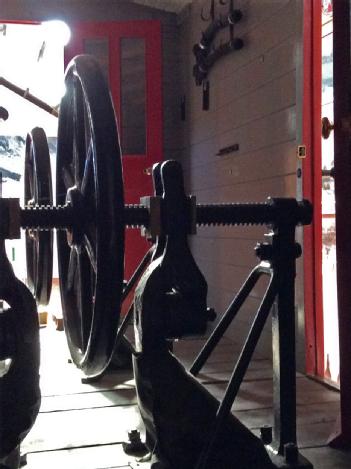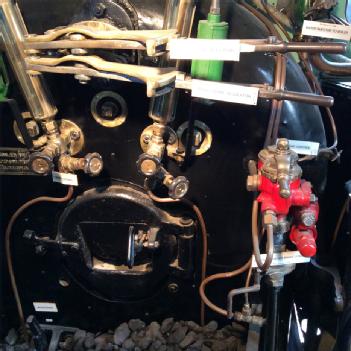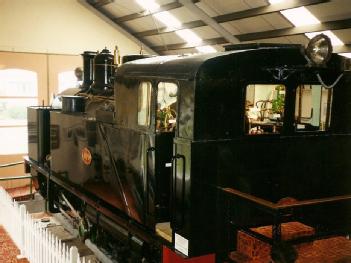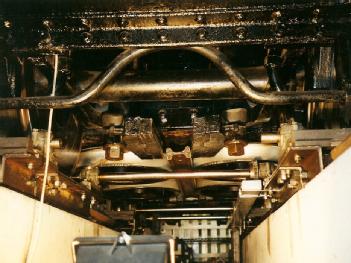
Fell Locomotive Museum |
5740 Featherston, New Zealand-Aotearoa (Wellington) |
|
| Address |
Cnr State Highway 2 and Lyon Street
|
| Floor area | unfortunately not known yet |
Museum typ
Mountain Railways & Cableways
|
Opening times
|
Weekdays: 10am - 4pm; weekends and public holidays: 10am - 4pm | ||||
|
Status from 10/2016
|
Adult $6; Children(over 5) $2; Family $13 | ||||
| Contact |
|
||||
| Homepage | www.fellmuseum.org.nz | ||||
Our page for Fell Locomotive Museum in Featherston, New Zealand-Aotearoa, is not yet administrated by a Radiomuseum.org member. Please write to us about your experience with this museum, for corrections of our data or sending photos by using the Contact Form to the Museum Finder.
| Location / Directions |
Featherston (Maori: Kaiwaewae) is a town in the South Wairarapa District, in the Wellington Region of New Zealand's North Island. It is at the eastern foothills of Rimutaka Range close to the northern shore of Lake Wairarapa, 63 km (39 mi) north-east of Wellington and 37 km (23 mi) south-west of Masterton. The Museum is located on the corner of State Highway 2 and Lyon Street in the center of Featherston. It is 63 kilometres (one hour’s drive) northeast of Wellington, or 57 kilometres by train. The Museum is a short walk from Featherston railway station. |
| Description | From Wikipedia, the free encyclopedia: The Fell Locomotive Museum in Featherston, New Zealand, exhibits the only remaining Steam Powered Fell railway locomotive in the world. Locomotive H 199 climbed 265 metres (869 ft) up the 4.8-kilometre (3.0 mi) Rimutaka Incline using John Barraclough Fell's unique method of four grip wheels on a raised centre rail. It is housed and tended to by a group of dedicated rail enthusiasts. H 199 is one of six H class locomotives designed for use on the 1 in 15 Rimutaka Incline, where they worked for 77 years. Their story is recalled by audio-visual programmes, models, photographs and memorabilia in the museum. From its humble beginnings, the Fell Locomotive Museum has grown to be a world recognised tourist attraction. FELL BRAKE-VAN F 210To safely operate the steep Rimutaka Incline, seven Fell brake-vans were built, two in England and five at the Petone railway workshops in Lower Hutt. The vans played an important part in the operation of the Rimutaka Incline. The brake gear comprised four upright cantilever arms pivoted on the floor of each van. On the lower ends of these arms were bolted the four brake blocks which gripped the centre rail.Fell mountain railway systemThe Fell system was the first third-rail system for railways that were too steep to be worked by adhesion on the two running rails alone. It uses a raised centre rail between the two running rails to provide extra traction and braking, or braking alone. Trains are propelled by wheels or braked by shoes pressed horizontally onto the centre rail, as well as by the normal running wheels. Extra brake shoes are fitted to specially designed or adapted Fell locomotives and brake vans, and for traction the locomotive has an auxiliary engine powering horizontal wheels which clamp onto the third rail. The Fell system was developed in the 1860s and was soon superseded by various types of rack railway for new lines, but some Fell systems remained in use into the 1960s. The Snaefell Mountain Railway still uses the Fell system for (emergency) braking, but not for traction.HistoryThe Fell system was designed, developed and patented by British engineer John Barraclough Fell. The first test application was alongside the Cromford and High Peak Railway's cable-hauled incline at Whaley Bridge in Derbyshire, England, in 1863 and 1864.These tests attracted the attention of the French Government, which conducted its own tests on the slopes of Mont Cenis in 1865. As a result, the Mont Cenis Pass Railway was built as a temporary connection between France and Italy whilst the tunnel under the Alpine pass was being built. New Zealand1,067 mm (3 ft 6 in) The Rewanui Incline on the West Coast of the South Island used a Fell rail for braking from its opening in 1914 to 1966. It closed in 1985.The Rimutaka Incline on the Wairarapa Line near Featherston in the North Island opened in 1878 and closed in 1955. It was replaced by the long Rimutaka tunnel. The Roa Incline on the West Coast of the South Island used a Fell rail for braking from its opening in 1909. It closed in 1960. The Kaikorai Cable Car which ran from Dunedin to the Kaikorai Valley used an off-centre fell rail for braking. 1,000 mm (3 ft 3 3⁄8 in) Funicular railway The Wellington Cable Car used a Fell rail for emergency braking from its opening in 1902 until 1978, when it was upgraded. unknown gauges Several bush tramways used Fell rails for braking. |
Radiomuseum.org presents here one of the many museum pages. We try to bring data for your direct information about all that is relevant. In the list (link above right) you find the complete listing of museums related to "Radio & Co." we have information of. Please help us to be complete and up to date by using the contact form above.
[dsp_museum_detail.cfm]
| Data Compliance | More Information |
 xtra.co.nz
xtra.co.nz 


